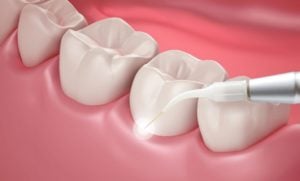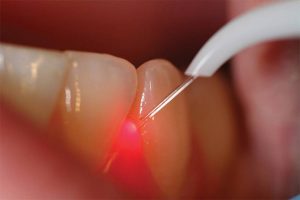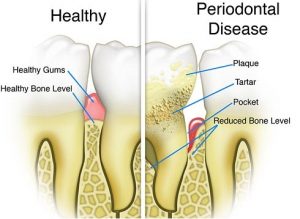Laser Gum Surgery LANAP Versus Traditional Gum Surgery
Laser Gum Surgery LANAP Versus Traditional Gum Surgery

When a patient has been diagnosed with gum disease, a periodontist will begin working with him or her to provide treatment options. Fortunately, there are various types of procedures and treatments that patients have to choose from in order to eradicate the disease. Each option has its own set of pros and cons, as well as risks and physical benefits. The two types of surgical treatments that are used most often are LANAP gum surgery and transitional laser gum surgery.
The following are examples of patient options to treat gum disease:
Nonsurgical Treatments
- root planing
- scaling
- antibiotics
Surgical Treatments
- flap surgery (pocket reduction surgery)
- soft tissue grafts
- bone grafting
- guided tissue regeneration
- tissue-stimulating proteins
Is Laser Periodontal Therapy (LANAP) Worth It?
LANAP stands for Laser-Assisted New Attachment Procedure and is the surgical therapy that is used in the treatment of peritonitis, or gum disease; and it is FDA approved. This procedure has been around for almost three decades. Alternatively, traditional gum surgery, also known as flap surgery, has been around for much longer. Due to the length of time both have been available as options to patients, there is significant research on the efficacy of both. Some experts believe that the efficacy of choosing a laser-type treatment over other treatment options is not necessarily much greater; but of course, there are proponents and opponents to every treatment option.
On the other hand, some periodontists prefer LANAP over other methods for a reason. It is important to remember that each patient is dealt with on a case-by-case basis and not all cases of periodontitis are identical. For some, the benefits of going through laser treatment outweigh that of the traditional method.
With all of that being said, there is substantial research that shows the efficacy of LANAP laser surgery is higher than that of traditional laser gum surgery.
What Are the Pros and Cons of the LANAP Laser Gum Surgery?
According to the LANAP site, the following are considered pros of having this type of surgery:
- Less post-operative pain — Using the PerioLase MVP-7 dental laser, the LANAP protocol helps avoid cutting and stitching of the gums. As a result, patients usually have minimal postoperative discomfort.
- Quicker recovery time — Immediately following the LANAP procedure, most patients are able to return to their regular daily activities, which generally requires less than a 24-hour recovery period. Following traditional scalpel and suture surgery, recovery can take two to four weeks, during which patients can experience considerable pain and swelling.
- Healthy gums with minimal recession — Because the LANAP protocol uses laser technology rather than cutting your gums, the tissue stays intact and is not compromised.
- Regeneration without foreign materials — Because the PerioLase laser stimulates your body’s own healing response, your LANAP dentist doesn’t have to add foreign ‘growth factors.’
There are not many experts who claim to admit to many cons of the LANAP procedure. Sometimes, however, depending on a patients’ circumstances, other more invasive surgeries would be more suitable and LANAP would not be appropriate.
What Can I Expect After Surgery?
Experts of traditional gum surgery (or flap surgery) describe it as where a dentist cuts into and peels back gum tissue with a scalpel. By doing so, the dentist is able to expose the roots of the teeth, making cleaning, bone reshaping and cutting gum tissue possible. Sutures are used to secure gums back in place.
Unfortunately, this doesn’t always serve to be effective or the gum disease has already damaged the bone around the tooth root; in which case, a bone graft would have to be done to repair the area.
The cost of laser gum surgery is truly dependent upon several factors and can range on average between $1,000 and $3,000 without insurance. These factors, according to the Consumer Guide to Dentistry are dependent on:
- the technology used in the procedure
- the location of your dentist
- the type of dental insurance you have
- the type of treatment plan required
- additional required procedures
The aftercare, or postoperative instructions for traditional laser gum surgery include that the patient do the following:
- to take prescribed pain meds as directed (if needed)
- be careful when chewing food (a liquid diet may be recommended)
- take precaution when brushing teeth; do not brush for one week
- no flossing for at least a month
Alternatively, the average cost of a LANAP procedure is between $4,000 and $15,000 for the full mouth, which is the only way LANAP is performed.
The aftercare, or postoperative instructions for LANAP surgery include that the patient do the following:
- leave any fibrous clotting material you encounter alone
- do not apply excessive tongue or cheek pressure to the treated area
- place an ice pack on face if swelling occurs
- no aerobic activity for 48 hours
- you may eat solid foods after a few days
- when eating do not chew on the side of your mouth which has been treated
With either procedure, follow-up care with the periodontist who performed the surgery, along with any maintenance he or she recommends is highly imperative to promote healing. It would not be wise to veer from professional advice.
As stated earlier, there will always be pros and cons, as well as benefits and disadvantages to any type of medical procedure, especially a surgery. It is best to not only listen to a licensed professional (dentist or periodontist) and to gather your own research from credible sources in order to make a sound decision regarding your health.
We are always here to help you make the most informed and educated decisions for your oral health. To schedule your free consultation with one of the experts here at Advanced Periodontics, dial (212)581-1090, today!






